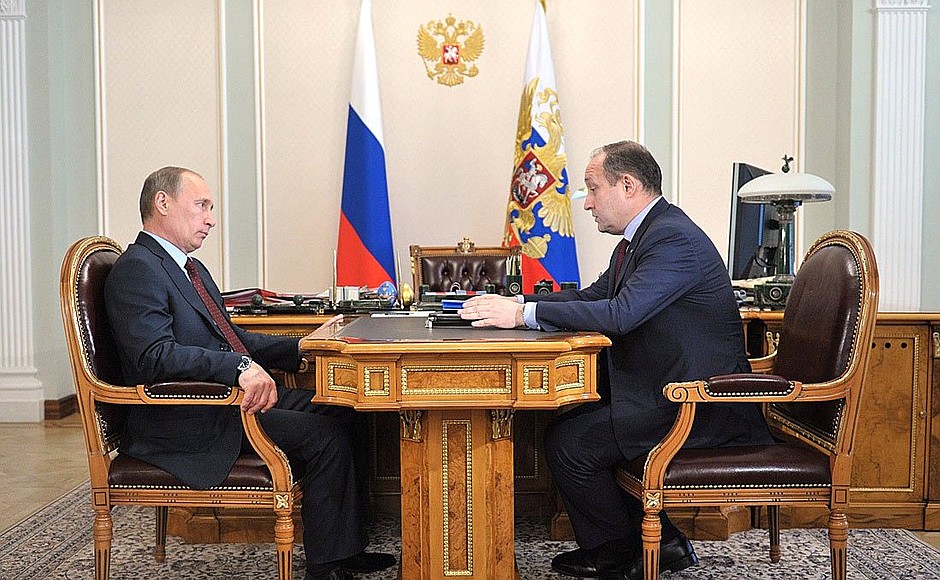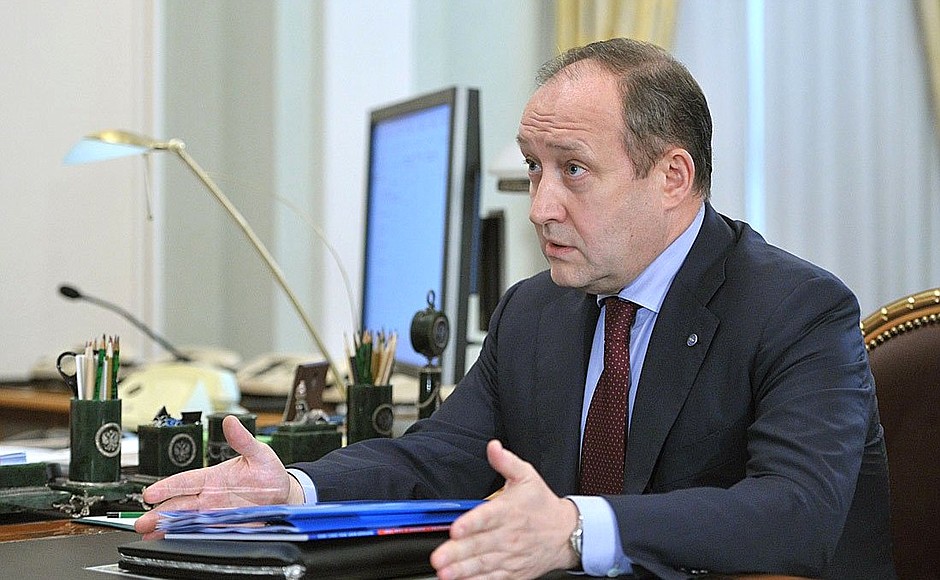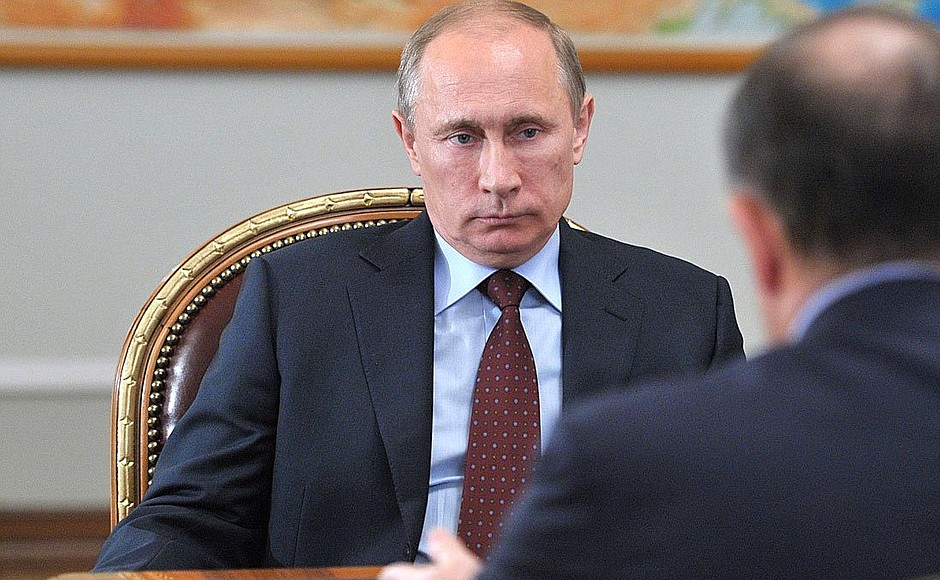President of Russia Vladimir Putin: Any news, Mr Frank? How is your company developing?
Sovcomflot CEO Sergei Frank: Mr President, Sovcomflot operates in the competitive international tanker shipping market. Despite the fact that this is the fifth year of the most severe recession in the tanker sector, we are reaching all the targets set out in the company’s development strategy and proceeding according to plan.
While realising the strategy over the past seven years, we’ve increased our fleet by 200%: we started in 2005 with four million dwt [deadweight tonnage], and today we have a fleet of 12 million dwt. We have mastered the technology of liquefied natural gas (LNG) shipping – a very promising area for Russia – and we have been able to make shuttle shipments in the Russian Arctic for the first time. We continue to gain experience along the Northern Sea Route, and we have a number of trips scheduled for this year.
Vladimir Putin: What work is being conducted offshore?
Sergei Frank: Let’s say that in the 1990s and the 2000s the main drivers of the company’s growth were foreign markets and shipping the cargo of international freighters. We refocused our strategy on the needs of Russian companies and we were right to do so, because now the main drivers of our growth are Russian projects on the continental shelf. We transport all the crude oil from the Sakhalin projects and the Varandey project, and nearly all the LNG from the Sakhalin projects.
The Sovcomflot tanker Yenisei has set out from Murmansk to Japan along the Northern Sea Route, a high-latitude route. In fact, this route is coming to life before our very eyes. A new icebreaking supply vessel, Alexei Chirikov, arrived in Sakhlin as requested by Rosneft and Exxon, the operators of the Sakhalin-1 project. The vessel was built jointly by Russian and Finnish shipbuilders and this series of ships will be further developed. We are currently taking part in Gazprom’s tender for four vessels for the Sakhalin-2 project.
There are some more good news: the ship Sibur Voronezh has started transporting LNG, just as SIBUR [gas processing and petrochemicals company] wanted. It was Russian projects and their good dynamics that have allowed us to maintain our position in the international tanker shipping market during the economic crisis.
Vladimir Putin: During what part of the year is the Northern Sea Route navigable?
Sergei Frank: Mr President, that is directly related to the Yenisei’s trip. In 2013 this large-capacity vessel – and let me emphasise that we are talking about transporting hydrocarbons on quite a large scale – was able to set out two weeks earlier than in 2010, 2011 or 2012. In other words, the window of opportunity for navigation – naturally, escorted by icebreakers, and in line with all the requirements and conditions of the Northern Sea Route administration – was two weeks earlier. In 2012 we finished our last trip on November 29; that is, almost in December.
One might say that there is a stable and reliable five-month window of opportunity during which it is possible to navigate the high-latitude route using proper navigation tools and accompanied by icebreakers. Even though the improvement of current equipment and the construction of additional new-generation icebreakers would expand this window of opportunity to six months. That is if trends we are currently seeing on the Northern Sea Route continue.
Vladimir Putin: And the most difficult part is near the New Siberian Islands?
Sergei Frank: Yes, the eastern Arctic is more constraining than the western part; that is obvious. And in recent years we have experienced the most difficulties in the Ayonsky ice mass, the area between the New Siberian Islands and Wrangel Island. That is, the eastern Arctic is more constraining than its western counterpart.
It is safe to say that year-round navigation in a westerly direction is possible for the Yamal projects; the route is already open. Naturally, the size of ships will increase, but this task is eminently doable. In current conditions, navigation in an easterly direction is likely to be limited to six months, that is, five to six months.
Vladimir Putin: In this connection, there’s another question that you and I have already discussed. You just mentioned that a new ship was built jointly with Finnish partners, but a significant number of orders were distributed to Russian shipyards. What will be your policy on shipbuilding orders in the near future?
Sergei Frank: Mr President, over the past five years we have invested 22 billion rubles [about $700 million] into Russia’s shipbuilding industry, and we are very satisfied with this work. That is, these are good ships and they operate in the market without any constraints. In coordination with the United Shipbuilding Corporation (USC) and its joint venture partners, we have invested a similar sum in projects related to technology transfer to Russia. On the whole, we are satisfied with this cooperation too.
Undoubtedly, our future priority is to develop civil shipbuilding in the Far East. We are guided in this respect by the USC, which has declared this its priority.
We have signed an agreement with Gazprom to develop a fleet of gas tankers with a capacity of 170,000 cubic metres, which will be produced at the Zvezda joint venture in the Primorye Territory. Gazprom offers good opportunities, and our shipbuilders see that they must set up production by the end of 2017–2018. Naturally, they have a lot of work ahead of them. But we will support them with orders, and naturally we will allow them to take advantage of this opportunity.
Vladimir Putin: How would you assess the value of these orders in the short term?
Sergei Frank: With regard to this series of vessels, we can say that if they go ahead with even half or a significant part of this order, investments will be in the billions of dollars. This is in the light of the fact that each such tanker costs over $200 million.
<…>


